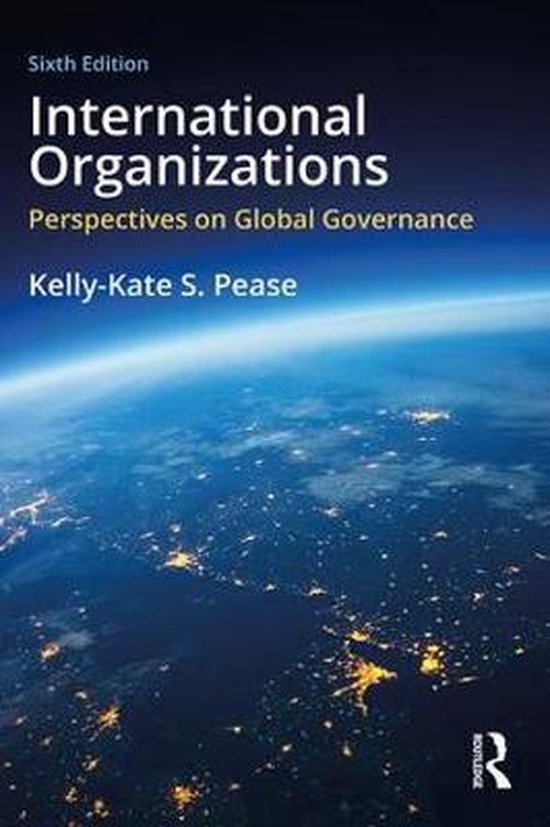Open exam: 60% of the final grade
Souheila Gharsalli
IGO’S & INGO’S
Week 5 -10 summary and book notes.
,IGOs & INGOs
Week 5 – the UN and international security CH. 5 pp 107 – 127 & 6 pp 156-167
What is international security?
- Traditionally, it has meant the security of states. Related to war and conflict between states.
Concerned with war prevention. The security of the sovereign states.
- Conflict: situation characterized by the incompatibility between two or more opinions,
principles and interests
- International War: armed conflict between two or more political communities/states
Why do conflicts/wars happen?
- 1. Because of different interests between two types of sovereign states, status-quo and
revisionist states
- Status quo state– satisfied with the way the international system works
- Revisionist state – a state that fights to change the system
Example: EU considered to be a status quo. Iranian president considered to be a revisionist state.
Security Dilemma
- 2. Conflicts appear even if nobody wants them: security dilemma: the defensive measures
taken to enhance one states’ security make other state feel insecure and inspire them to
respond with their own defensive measures, making the initial states feel insecure, and so
on.
- Example: security dilemma between north and south Korea.
How can war be prevented?
The balance of power
- Parity between competing forces, great powers coming together in reaction against threat.
- Goal: prevent any one state from becoming so strong as to impose its will/might on the rest
of the international community
- Ex.: Congress of Vienna, concert of Europe, Cold War
Collective Defense
- Alliance system in response to a specific threat. Based on an alliance of states in which an
attack by a third state commits the participants in the arrangement to aid of the state under
attack.
- Example: NATO. Art. 5: one for all and all for one. Collective defense can reduce any single
state's cost of providing for its security by combining and pooling resources
- BUT: there are risks that states will be drawn into war.
Collective Security
- The security of one is the security of all. Arrangement in which all states cooperate to
provide security for each other by taking all necessary action against any state which uses
force against others.
, - Sense of common trust and determination must exist to prevent aggression between all the
states
Example: The League of Nations
- created in the expectation that there would be a harmony of interests between all member
states which would provide the basis for collective security
- Failed
Comparing the three types of alliances
Presence of Formal Relationship Examples
threat agreement between allies
(treaty)
Balance of power Yes No enemies Concert of
Europe, WW2
Collective Yes Yes Partners/rivals NATO (until 1991,
defense after the solution
of the SU and the
end of cold war)
Collective No yes Friends League of
security Nations, UN,
NATO (after
1991)
Contemporary wars
Traditionally war implies aggression: land grab, involving the use of clearly identifiable regular
military forces
After WWII, this became ambiguous: land grab rare, replaced by: proxy wars, insurgency, anti-
colonial rebellions, terrorism.
Both state and non-state actors involved in violence and claim the legitimate right to use force
The United Nations
The History
- January 1942: Atlantic Charter, 26 governments
- Created in 1945 at the end of WWII
- Representatives from 51 countries met in San Francisco to draft the UN Charter
- Signed on the 26th of June and came into effect on 24th of October 1945 (UN Day) when the
Charter was ratified by China, France, the UK, the US and the USSR
The Purposes
Chapter I, art. 1 of the UN Charter
1. To maintain international peace and security
2. To develop friendly relations among nations
3. To address economic, social, cultural and humanitarian problems
4. To promote respect for universal human rights
, The principles
Chapter I, art. 2 of the Charter:
1. Sovereign equality of all member-states
2. Obligations for all member-states
3. Peaceful settlement of disputes
4. Non-use of force
5. Non-intervention in domestic affairs of member-states
The Structure
6 principal organs:
1. The General Assembly
2. The Security Council
3. The Economic and Social Council
4. The International Court of Justice
5. The Secretariat
6. The Trusteeship Council (inactive)
The General Assembly
- Similar to a parliament, but does not produce binding law
- Can deliberate and consider any issue or question arising under the UN Charter
- Authority to make recommendations regarding international security (Art. 10, 11). Uniting
for Peace Resolution (1950): in case of lack of unanimity among permanent SC members, the
GA can step in.
- Decides on admission of new members on proposal of the Security Council (UNSC)
- Drafts and approves the UN budget (Art. 17)
- Oversees UN bureaucracy, elects non-permanent members of UN SC, all members of
ECOSOC, Secretary General (proposal of UNSC) and 15 judges of ICJ
- All 193 states represented with a simple majority deciding most issues, important issues: 2/3
majority (ex. Security). One state one vote
- Meets in regular sessions from September to December and as needed in UN headquarters
in New York
The Security Council
- Most important Organ charged to maintain international peace and security (identify threats,
craft response, build consensus, carry out actions)
- Resolutions taken under Chapter VII (7) are binding
- Includes 5 permanent members with the right of veto and 10 non-permanent/elected by GA
members
- Resolutions pass with 9 votes (with the permanent members included)
- Permanent residence at UN headquarters in New York






